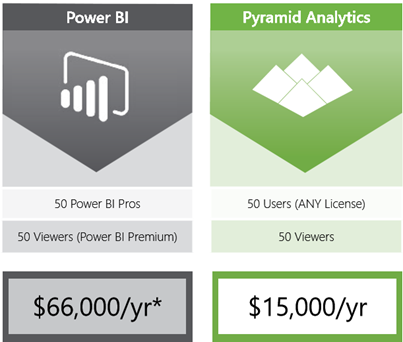Power BI vs. Pyramid
I’ve never thought I’d see this one coming but today I got a marketing email from Pyramid Analytics (previously an ardent Microsoft partner) citing a head-to-head comparison with Power BI. Et tu, Brute?
“Let’s start with a clear pricing model – one that doesn’t require an online calculator to figure out annual costs. Let’s add in fundamental capabilities and features like dashboarding, KPI’s, dicing, time intelligence, parameterization, and asymmetric reporting. Let’s close out with a complete lack of narrative reporting capabilities. The Pyramid Analytics platform provides an enterprise class on-premises BI solution that delivers all of the above plus simple advanced analytics. It’s available now and at a price you can easily understand. There’s a clear choice. Click here for a head-to-head comparison and a limited time offer”
I pity any vendor that competes with Power BI, especially the ones that compete “head-to-head”. Pyramid must feel the heat to come up with this “The Choice is Clear” marketing banner. But to me it’s not very clear and to keep ’em honest, their costing comparison is fabricated. According to Pyramid, you have to cough up $66,000/year for 100 users. But wait, the asterisks below tells us “*If data becomes too large for a single P1 node, additional nodes can be purchased for an additional $60,000/yr”. The choice is clear, right?
Actually, it’s not and you don’t need the online calculator. It’s true that if you go with Power BI Premium, you’d pay $66,000 but why would you for 100 users (or 50 viewers to be more accurate)? If you choose instead the per-user pricing model ($10/user/mo), then your cost would be $12,000 per year not considering any additional discount you might get from Microsoft. So, that’s $3,000 lower than Pyramid. And, you’ll get a cloud solution that improves every month, plus a free Power BI Desktop tool. Or, if you want to save even more, you can go on-prem by deploying to Power BI Report Server which might be covered by an existing SQL Server Enterprise Edition license. Then, your software cost might be zero, plus one or more Power BI Pro $10/mo licenses for report authors.
Aside the Power BI Premium-only features, from a pure costing perspective switching to Power BI Premium makes sense above 500 users. It’s simple math.
About the second “Head-to-Head Comparison” page that shows that Pyramid outshines Power BI in every possible way, it doesn’t mean much without substance. I’m looking forward to the extended banner with more detail that explain how Pyramid exceeds the Power BI dashboarding, KPI, dicing, time intelligence, parameterization, and asymmetric reporting (whatever this means) capabilities. As far as “complete lack of narrative reporting capabilities”, this is not true either. Power BI has a Narative Science custom visual and Pyramid should know this.





